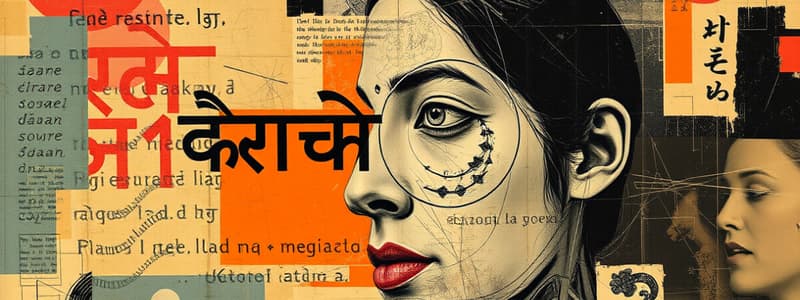Podcast
Questions and Answers
What is the primary official language of India?
What is the primary official language of India?
- Telugu
- Bengali
- Punjabi
- Hindi (correct)
Which script is used to write Hindi?
Which script is used to write Hindi?
- Arabic
- Devanagari (correct)
- Cyrillic
- Latin
What is the sentence structure of Hindi?
What is the sentence structure of Hindi?
- Subject-Verb-Object (SVO)
- Verb-Subject-Object (VSO)
- Subject-Object-Verb (SOV) (correct)
- Object-Subject-Verb (OSV)
Which of the following is NOT a dialect of Hindi?
Which of the following is NOT a dialect of Hindi?
What languages have influenced Hindi vocabulary?
What languages have influenced Hindi vocabulary?
Which work is a significant piece of Hindi literature?
Which work is a significant piece of Hindi literature?
What is Hindustani?
What is Hindustani?
Where is Hindi recognized as a minority language?
Where is Hindi recognized as a minority language?
Flashcards are hidden until you start studying
Study Notes
Overview of Hindi
- Hindi is an Indo-Aryan language derived from Sanskrit.
- It is the primary official language of India and spoken by over 500 million people.
- Hindi is part of the larger family of Indo-European languages.
Script
- Written in Devanagari script, which consists of 47 primary characters.
- The script is phonetic, meaning it represents sounds directly.
Dialects
- Numerous dialects exist, including:
- Awadhi
- Bhojpuri
- Maithili
- Haryanvi
- Standard Hindi is based on the Khariboli dialect, spoken in and around Delhi.
Grammar
- Subject-Object-Verb (SOV) sentence structure.
- Gendered nouns (masculine and feminine).
- Use of postpositions instead of prepositions.
- Extensive use of compound verbs.
Vocabulary
- Rich vocabulary influenced by:
- Sanskrit
- Persian
- Arabic
- English
- Incorporates loanwords from these languages due to historical interactions.
Literature
- Hindi literature has ancient roots with significant works like:
- "Ramcharitmanas" by Tulsidas
- Poetry from the Bhakti movement
- Modern literature includes novels, poetry, and plays by authors like Premchand and Harivansh Rai Bachchan.
Cinema
- Bollywood, the Hindi film industry, is one of the largest in the world.
- Hindi films often incorporate music, dance, and dramatic storytelling.
Cultural Significance
- Hindi plays a vital role in Indian culture, traditions, and social practices.
- National integration and identity, promoting unity in diversity.
Language Variants
- There are many regional variations and forms, such as:
- Hindustani, a blend of Hindi and Urdu.
- Common in music, poetry, and informal communication.
Learning Hindi
- Important for cultural exchange and understanding Indian society.
- Resources available include language courses, textbooks, and online platforms.
Global Presence
- Hindi is spoken in various countries outside India, including:
- Fiji
- Nepal
- Mauritius
- Trinidad and Tobago
- It is recognized as a minority language in several nations.
Overview of Hindi
- Hindi is an Indo-Aryan language that evolved from Sanskrit.
- It serves as the primary official language of India, utilized by over 500 million speakers.
- Falls under the larger Indo-European language family.
Script
- Utilizes the Devanagari script, comprising 47 primary characters.
- The script is phonetic, directly representing spoken sounds.
Dialects
- Hindi encompasses numerous dialects, including Awadhi, Bhojpuri, Maithili, and Haryanvi.
- Standard Hindi is derived from the Khariboli dialect, recognized in regions around Delhi.
Grammar
- Features a Subject-Object-Verb (SOV) sentence structure.
- Nouns are gendered, classified as either masculine or feminine.
- Employs postpositions instead of prepositions.
- Commonly uses compound verbs for expression.
Vocabulary
- Hindi boasts a rich lexicon heavily influenced by Sanskrit, Persian, Arabic, and English.
- Historical interactions have led to the incorporation of numerous loanwords.
Literature
- Hindi literature has ancient origins, with notable works like "Ramcharitmanas" by Tulsidas and poetry from the Bhakti movement.
- Contemporary literature includes novels, poetry, and plays by authors such as Premchand and Harivansh Rai Bachchan.
Cinema
- Bollywood, the Hindi film industry, ranks among the largest globally.
- Hindi films characteristically blend music, dance, and dramatic narratives.
Cultural Significance
- Hindi is integral to Indian culture, traditions, and social interactions.
- It promotes national integration and identity, fostering unity in India's diversity.
Language Variants
- Includes various regional forms, such as Hindustani, which merges Hindi and Urdu.
- Hindustani is prevalent in music, poetry, and everyday informal discourse.
Learning Hindi
- Learning Hindi is essential for cultural exchange and comprehension of Indian society.
- Accessible resources for learning include language courses, textbooks, and online platforms.
Global Presence
- Hindi is spoken in several countries outside of India, such as Fiji, Nepal, Mauritius, and Trinidad and Tobago.
- It is acknowledged as a minority language in various nations, reflecting its global reach.
Studying That Suits You
Use AI to generate personalized quizzes and flashcards to suit your learning preferences.




